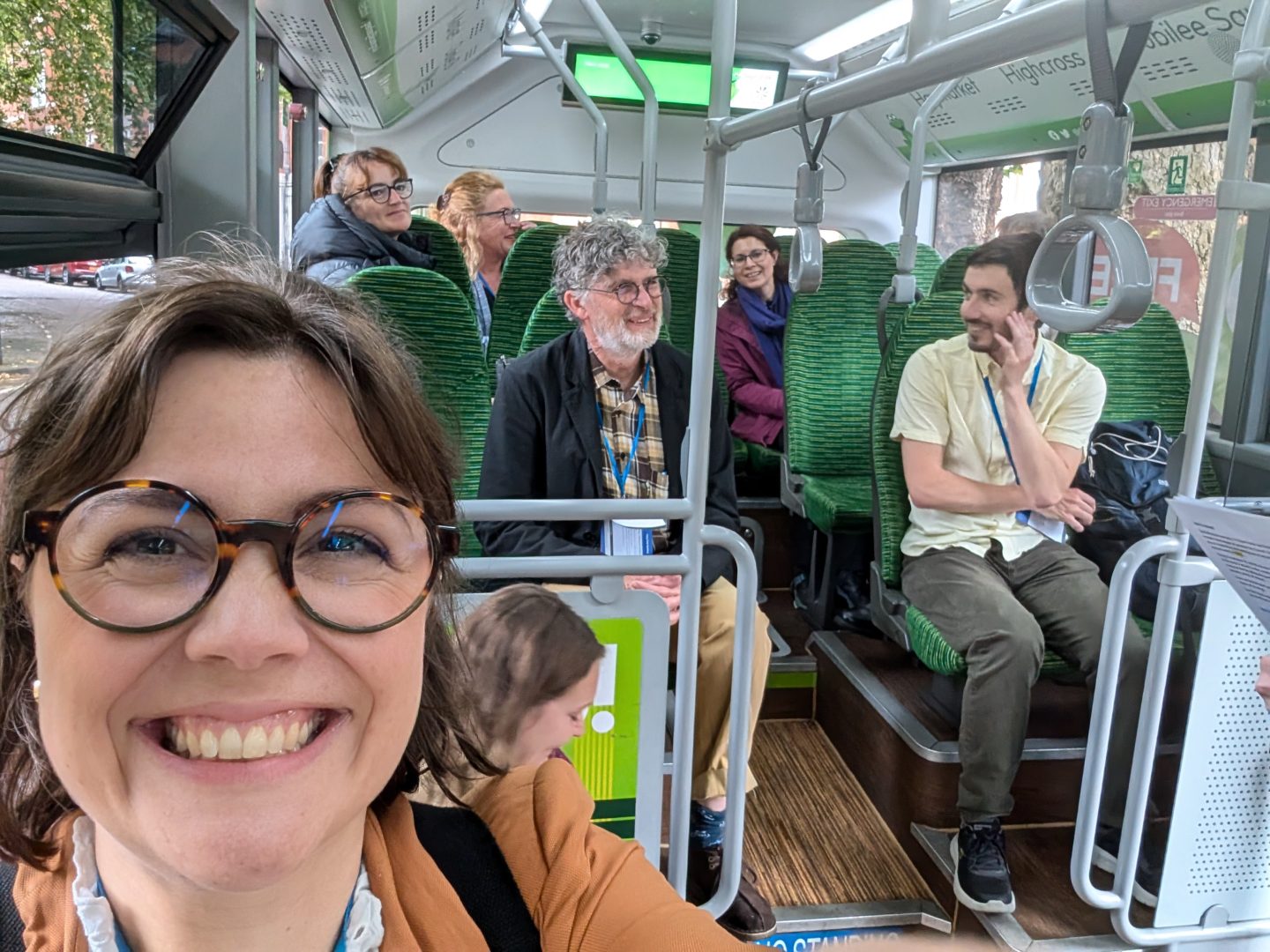Transport Planning Associate Director, Mailys Garden, and Highways Associate, Eduardo Moral, were at the Landor Links Active City Conference, hearing fellow professionals discuss key topics and active travel insights.
Eduardo is one of our experienced active travel specialists. Based in our Edinburgh office, he has contributed to some of our most successful schemes, improving infrastructure, highways and sustainable transportation.
Mailys is Project Centre’s Associate Director for Transport Planning. She is a specialist in transport strategies supporting road space re-allocation including freight, parking and active travel. Mailys is also an industry-recognised champion through numerous contributions to research, articles and events in the transport industry.
Following the conference, Eduardo and Mailys provided us with some key points of discussion, questions they asked themselves and ways to solve the challenges around them.
Eduardo commented: “I left the conference with lots to reflect on. I work on active travel schemes almost every day for rural or urban areas both in Scotland and England and the conference was a great opportunity to catch up with fellow professionals and share some in-depth industry knowledge.”
“I hugely enjoyed exploring all the new active travel and public transport infrastructure that Leicester has put forward in the past decade. Strong leadership, technical capability and continuity of personnel has meant lessons are learnt quickly and the pace of the transformation keeps up with the climate and health challenges we all face.” Mailys added.
“I particularly appreciated the attention given to providing inclusive infrastructure for people with a diversity of mobility needs. This sets Leicester on an enviable path to ensure resilience with an ageing population. It is excellent to see real-life examples that we can use when creating accessibility guidance documents such as the ones we have been commissioned to do for the Liverpool City Region Combined Authority.”
Q. Are we, as active travel practitioners, collaborating effectively with stakeholders such as bus operators, housing developers and delivery drivers, to achieve a holistic approach to active travel implementation?
Eduardo: Stakeholders in the industry complain about a reoccurring lack of involvement in the design process. This can cause several issues following their implementation.
At Project Centre, we value communicating and collaborating with stakeholders from an early stage of the project. We usually kick start our projects with a discovery meeting, to understand our client goals and requirements.
Collaboration among various stakeholders is then essential to ensure seamless connectivity, accessible designs and sustainable logistics and transport spaces. By fostering an inclusive approach, we can support a balanced development of all active travel modes, ensuring we don’t leave anyone behind.
For example, in North Lanarkshire, we developed a comprehensive mapping of stakeholders and a programme with key messaging. This allowed us to prioritise inclusion in our stakeholder engagement and to maximise participation.
We developed measures to mitigate barriers to participation, such as providing a reply-paid hard copy of the survey to specific properties, offering information in another language as necessitated by census data, or providing phone engagement opportunities to ensure people are not digitally excluded from engagement.
Q. Are we at risk of disregarding walking and wheeling in favour of cycling?
Mailys: Key stakeholders and our local authority clients are very clear that active travel is first and foremost walking and wheeling. The overwhelming majority of our journeys start by walking – even if it’s just to where we have parked our bike, or to the local bus stop! So it is essential that in promoting active travel, we ensure that walking and wheeling are not overshadowed by cycling. Some of the main reasons include:
- Short distances
Walking is often the most convenient option for short trips. Reducing car dominance, improving crossings, and enhancing public spaces and streets can help us drive behaviour change.
- Integration with cycling
We don’t need to penalise walking just because we’re trying to improve the cycle paths. Designed shared spaces should accommodate cyclists and pedestrians and we can encourage this through clear signage and markings. Also developing policies that prioritise pedestrian and wheeling infrastructure can help the community feel safer while travelling around their areas.
- Accessibility opportunities
Walking and wheeling are crucial for people with disabilities and those who rely on mobility aids. We want to ensure the infrastructure supports all forms of active travel equally.
Q. Should we focus more on promoting active travel in rural areas?
Mailys: From a transport planning perspective, rural areas are more challenging due to lower residential densities and greater distances to be covered for people to reach their destinations. So, to build an investment case we need to consider several parameters in addition to more urban areas such as recreational active travel and crucially multi-modal journeys (hopping on the bus or the train and then walking or cycling for instance). We also need to consider wider benefits such as healthier lifestyles. The current lack of access to exercise increases ill health, impacting workforce productivity with a knock-on effect on the economy and pressure on our health and social care systems.
Eduardo: From a design perspective, rural areas present unique challenges and opportunities for promoting active travel, including enhanced scenic routes, green corridors and cultural trails. There are a few ways we can promote a more comprehensive approach, such as addressing specific challenges around visual and ecological impact, reduced accessibility and land ownership.
At Project Centre, we work on numerous schemes to enhance active travel in rural areas. For example, in Herefordshire, there was a strong desire to create new space for cycling priority crossings. Due to the area’s nature, we are using technological advancements to deliver project aims like solar lighting.
In the Liverpool City Region Combined Authorities areas, a greater emphasis was on the delivery of direct routes that required redistribution of vehicular movements.
These ensured that the LTN 1/20 core design principles (coherence, directness, safety; comfortableness and attractiveness) and stakeholders’ needs were always at the forefront of design. This process was delivered during the COVID-19 pandemic forcing us to think outside of the box and use alternative methods of designing and engaging with residents and businesses using enhanced local knowledge. As Active Travel England’s representatives mentioned during the conference, designs compliant with national guidance such as LTN 1/20 have demonstrated to lead to successful schemes.
Q. Do we have a clear understanding of what makes people shift towards active travel and then what promotes consistent uptake and encourages others to follow?
Mailys: To me, we need to move away from considering pedestrians and cyclists ‘against’ car users. The reality and complexity of the journeys we undertake daily mean the greatest opportunity lies in converting these journeys, or at least a proportion of those with shorter distances travelled.
We need a longer-term behavioural and cultural shift to collectively own this transition. Everything we hear from surveys and focus groups tells us people want safer streets, clean air and greener public spaces. There are a huge number of benefits we need to promote to encourage a consistent uptake – health, economy and environment amongst the top ones.
To encourage people to adopt and maintain active travel habits, we need to identify key motivators and strategies that drive change. Research shows that how we frame messages matters, and that words and concepts we use are important. Evidence shows people are more receptive to positive narratives, referring to civic-mindedness and collective responsibility rather than imposing on choice.
We extensively work in collaboration with our communication and engagement team to involve the community from the early stage of a project, driving behaviour change. In often complex schemes, such as moving traffic enforcement in Manchester, School Streets in Medway and pavement parking in Edinburgh, community feedback ensured solutions are tailored to specific local contexts, leading to more effective and sustainable designs.
By prioritising community involvement, our designs become more inclusive, equitable and effective, ultimately leading to better living environments for everyone.




